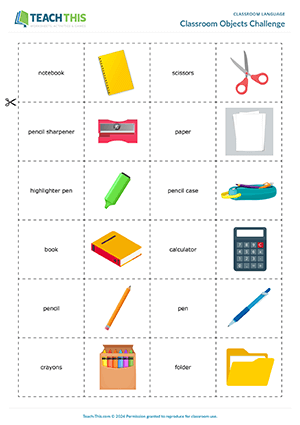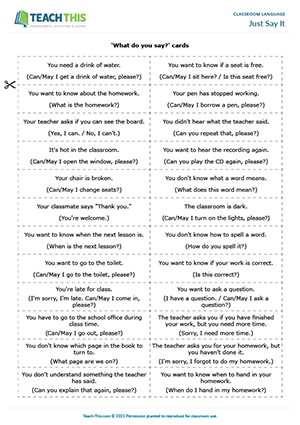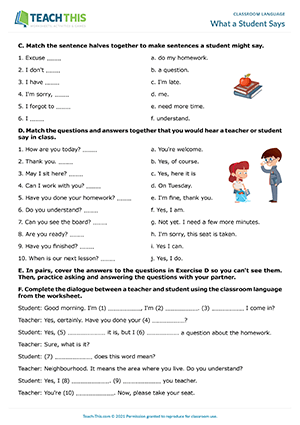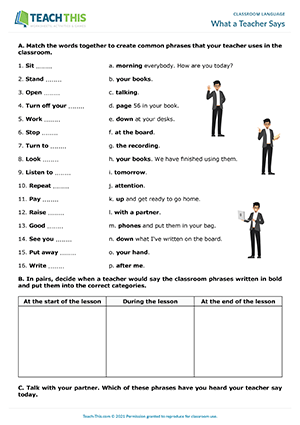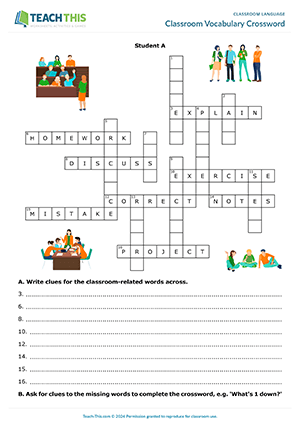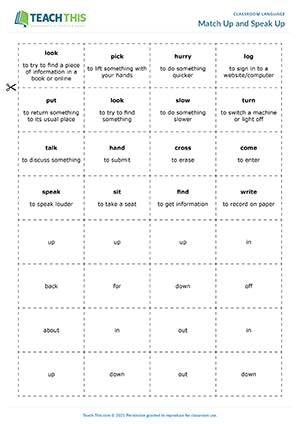Here are two engaging classroom object games to help students learn and practice the names of common classroom objects. First, students play a pelmanism game where they match the names of classroom objects to pictures. In pairs, students take turns turning over a word card and a picture card. If the classroom object word matches with the picture, the student keeps the two cards and has another turn. If the two cards don't match, the student turns them back over. The student with the most pairs of cards at the end of the game wins. Next, students play a game in which they make sentences using the classroom objects vocabulary. Students take turns picking up a word card and reading the classroom object to their partner, who has 20 seconds to make a meaningful sentence using the word. If the student makes an appropriate sentence, they keep the card. If not, the card is placed at the bottom of the pile. The student with the most cards at the end of the game is the winner.
Here is a free classroom language game to help students practice classroom phrases and commands. Teams take turns rolling the dice. If a team rolls an odd number, a team member picks up a classroom command card and mimes the command to their teammate who has 30 seconds to say what it is. If the student is successful, the team wins and keeps the card. If not, the other team has one chance to guess and win the card. If a team rolls an even number, a team member picks up a 'What do you say?' card and reads the classroom situation on the card to their teammate who has 30 seconds to say the corresponding classroom language shown on the card. If the student says the correct classroom language, the team wins and keeps the card. If not, the other team tries to guess the answer. The team with the most cards at the end of the game wins.
In this useful classroom language worksheet, students learn and practice language used by a student during English class. Students begin by completing questions a student might ask during class with question words from a box. Next, students read classroom situations and write down which question they would use from Exercise A for each one. Students then match sentence halves together to make sentences a student might say in class. After that, students match questions and answers together that they would hear a teacher or student say. In pairs, students then cover the answers to the questions and practice asking and answering the questions with their partner. Lastly, students complete a short dialogue between a teacher and student using the classroom language from the worksheet.
This comprehensive classroom language worksheet helps students learn expressions used by a teacher during a typical English lesson. Students start by matching words together to create common phrases that a teacher uses in the classroom. Next, in pairs, students decide when a teacher would say the classroom phrases and put them into three categories, at the start of the lesson, during the lesson, and at the end of the lesson. Students then try to remember which of the phrases they have heard their teacher say already during the lesson. After that, students complete sentences with classroom language. Finally, students complete sentences with classroom object words from a box.
In this enjoyable classroom vocabulary crossword activity, students complete a crossword by defining and guessing classroom and learning-related words. First, in two groups, students invent and write down clues for the classroom and learning-related words written on their crossword. For example, if the word was subject, students might write 'Something that you study at a school or university.' Next, students pair up with someone from the other group and take turns asking their partner for a clue to one of their missing classroom-related words. Their partner reads out the clue for that word, and the other student tries to guess what it is. If the student guesses the word successfully, they write it on their crossword. If not, their partner continues to give more clues until the student is able to guess the word. Afterwards, students check their spelling by comparing crosswords.
In this fun classroom phrasal verbs game, students match verbs with prepositions to form classroom phrasal verbs and then use them in sentences. In pairs, students take turns turning over one verb card and reading the verb and definition on the card. Next, the student turns over one preposition card to try to find a matching preposition. If the preposition matches the verb to form the classroom phrasal verb described in the definition, the student scores a point and keeps the two cards. The student then tries to score an extra point by using the phrasal verb in a meaningful sentence. If the student is able to make a suitable sentence, they score the extra point and have another turn. If the two cards don't match, the student turns them back over. The student with the most points at the end of the game wins.
Latest Free
Resources
- Jigsaw Reading
Reading Exam Preparation (B1)
Date Added: 7th of March
- Writing Jeopardy
Writing Exam Preparation (B1)
Date Added: 6th of March
- Present Perfect Bingo
Present Perfect Yes No Questions (A2)
Date Added: 4th of March
- Count on Me!
Making Offers and Promises (A2)
Date Added: 11th of February
- It’s Carnival Time!
Cultural Celebrations (B1)
Date Added: 29th of January
Latest Member
Resources
- Shops and What They Sell
Shopping (B1)
Date Added: 12th of March
- Who has written this?
Present Perfect Yes No Questions (A2)
Date Added: 11th of March
- Business Greetings and Introductions
Networking (B2)
Date Added: 11th of March
- Have you done this?
Present Perfect Yes No Questions (A2)
Date Added: 7th of March
- True, False or Not Given
Reading Exam Preparation (B2)
Date Added: 7th of March



